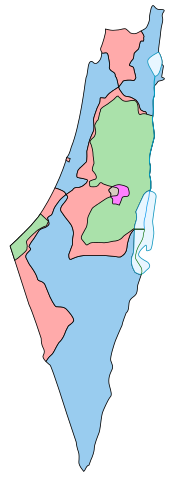 |
This is a file from the Wikimedia Commons. Information from its description page there is shown below.
Commons is a freely licensed media file repository. You can help.
|
Summary
| Description1947-UN-Partition-Plan-1949-Armistice-Comparison.svg |
English: Comparison between the boundaries in the November 29th 1947 United Nations General Assembly partition plan ( Resolution 181) for the British Mandate Territory of Palestine and the eventual armistice boundaries of 1949-1950. The meaning of the map colors is as follows (a legend caption is available in template form here):
- Blue = area assigned to a Jewish state in the original UN partition plan, and within the 1949 Israel armistice lines.
- Green = area assigned to an Arab state in the original UN partition plan, and controlled by Egypt or Jordan from 1949-1967.
- Light red = area assigned to an Arab state in the original UN partition plan, but within the 1949 Israel armistice lines.
- Magenta = area assigned to the "Corpus Separatum" of Jerusalem/Bethlehem (neither Jewish nor Arab) by the plan, but controlled by Jordan from 1949-1967.
- Greyish = area assigned to the "Corpus Separatum" of Jerusalem/Bethlehem (neither Jewish nor Arab) by the plan, but within the 1949 Israel armistice lines.
Some limitations of the map:
- The small demilitarized zones are not shown. Arabs interpreted these areas as neutral intermediate buffers (like the Neutral Zones between Iraq and Saudi Arabia, or between Kuwait and Saudi Arabia), while Israel interpreted them as full sovereign Israeli national territory under a demilitarization treaty obligation. The conflict between these two interpretations produced frictions which effectively eliminated the special status of most of the zones within a few years.
- A small area at the northeastern corner of the green area on the map -- which would have belonged to the Jewish state according to the original UN partition plan, but which was controlled by Jordan from 1949-1967 -- is not distinguished on the map.
- The Latrun Salient no-man's-land is not shown separately, and the line between green and light red in that area is somewhat fudged. The boundary complications in the Jerusalem area (the Jerusalem no-man's-land, Mount Scopus theoretical enclave, etc.) are too small to show up on a map of this level of detail.
- The map cannot show that the pre-1948 boundaries of the British Palestine Mandate included a ten-meter-wide strip along the northeastern shore of the Sea of Galilee (making it a fully-enclosed British mandate lake), a strip which was overrun by Syria in the fighting of 1948-1949.
|
| Date |
13 July 2007 |
| Source |
This is a partial SVG conversion (omitting text) of the original PostScript vector source of raster Image:1947-UN-Partition-Plan-1949-Armistice-Comparison.png by User:AnonMoos. Apparently, http://unispal.un.org/UNISPAL.NSF/0/651C804E6815FB28852575DF004B7C4C, ANNEX II, is the real (UN) source. |
| Author |
AnonMoos |
Licensing
| Public domainPublic domainfalsefalse |
 |
This work has been released into the public domain by its author, AnonMoos. This applies worldwide.
In some countries this may not be legally possible; if so:
AnonMoos grants anyone the right to use this work for any purpose, without any conditions, unless such conditions are required by law.Public domainPublic domainfalsefalse
|
File usage
The following pages on Schools Wikipedia link to this image (list may be incomplete):
This file contains additional information, probably added from the digital camera or scanner used to create or digitize it. If the file has been modified from its original state, some details may not fully reflect the modified file.
SOS Children chose the best bits of Wikipedia to help you learn. SOS Childrens Villages believes education is an important part of a child's life. That's why we ensure they receive nursery care as well as high-quality primary and secondary education. When they leave school, we support the children in our care as they progress to vocational training or higher education. There are many ways to help with SOS Children.



